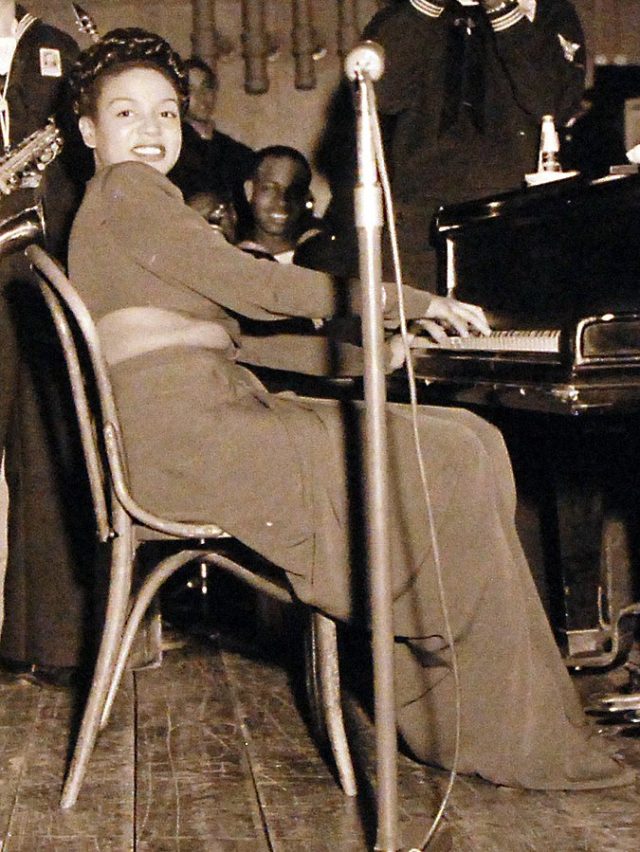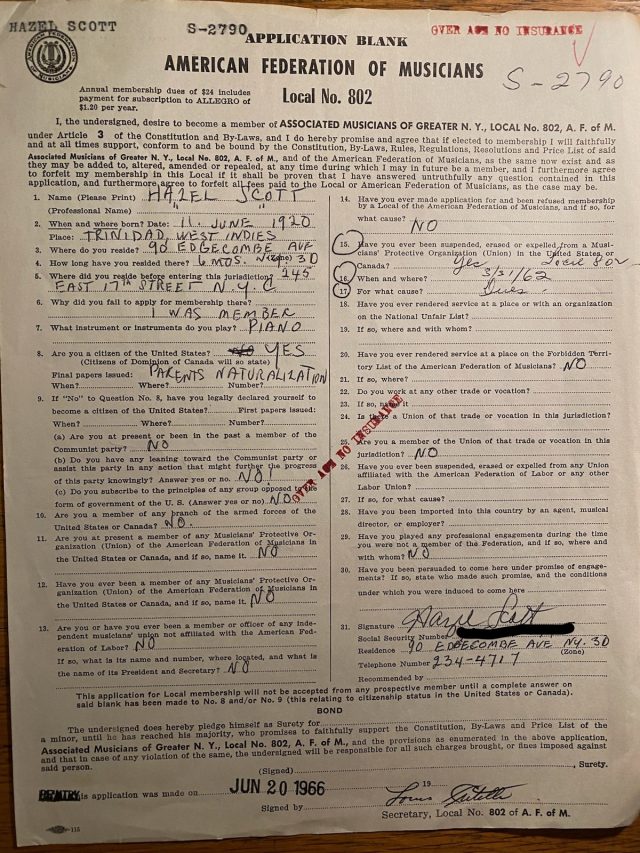Allegro
Hazel Scott: from child prodigy to renowned performer
Women's History Month
Volume 123, No. 3March, 2023

Hazel Scott in 1943 (Wikipedia)
By the time Hazel Scott reapplied for membership in Local 802, she’d lived more in her 46 years than most could in a lifetime. From child prodigy to renowned performer, she was a major recording artist and noted film actor, as well as the first African American artist to host her own programs on both radio and television. In a tragic turn, this acclaim was followed in 1950 by a racist, red-baiting campaign by the forces of reaction, particularly the House Un-American Activities Committee. Almost immediately thereafter, her television show was canceled, and Scott suffered the indignity of media blacklisting and a mental breakdown. By the late 1950s, her prominent marriage to Adam Clayton Powell Jr had eroded and she’d left New York for Paris, returning only with her own healing and the racial advances of the next decade. Still, her story is one that has rarely been told.
The Trinidad-born pianist and vocalist began her prodigious career as a child, and in 1924, when she was four years of age, relocated to New York City with her family. Scott’s perfect pitch and outstanding instrumental ability led her mother Alma Scott (also a musician), four years later, to bring her to the attention of Julliard professor Oscar Wagner who provided Hazel advanced musical training. By the age of 11, she’d already made her professional debut.
A performance at Roseland led to a contract with WOR radio and, over the next few years, celebrated gigs at increasingly prestigious nightclubs. When she was 19, Scott began a residency at Café Society, casting an important series of Swinging the Classics, bridging the jazz she loved (and would go on to perform with the likes of Charles Mingus and Max Roach) and the classical music she’d showcased over the years. Barney Josephson, Café Society’s owner and a virulent opponent of segregation, became Scott’s manager and assured that her bookings were for integrated audiences, and supporting her when racist incidents occurred along the way.
In such a climate, with neighborhoods (and the active U.S. military) so coldly separated by race, one might assume that an artist like Scott could never proliferate, yet she was called out to Hollywood and offered a Columbia Pictures contract. Pridefully, she insisted on terms that were shocking at the time, including the control of character and costume, making several movies including one with Lena Horne. Following a successful protest action when she refused for the other Black actresses in a film to be dressed in soiled aprons (holding up production for three days!), Columbia head Harry Cohn threatened to close Scott out of all film work; she returned to New York and resumed her successful music career. Later, she markedly stated: “From Birth of a Nation to Gone with the Wind, from Tennessee Johnson’s to My Old Kentucky Home; from my beloved friend Bill Robinson to Butterfly McQueen; from bad to worse and from degradation to dishonor — so went the story of the Black American in Hollywood.”
In 1944, the FBI opened a file on Scott (I’ve uploaded a copy here), citing her involvement in the Civil Rights Congress and the ACLU’s American Committee for the Protection of the Foreign Born as well as her professional association with the openly left-wing Barney Josephson. Her marriage a year later to the dashing, newly-elected Congressman Adam Clayton Powell Jr and the headlines they achieved after protesting Scott being barred from performing at Constitution Hall by the bigoted Daughters of the American Revolution was apparently what the festering right-wing was seeking. Scott was a force, establishing a 1950 battle against the National Press Club’s racist admission policy and a civil rights lawsuit against a Spokane WA restaurant that refused to serve her (following a USO performance).
That same year, Scott’s successes in television guest appearances led to the premiere of The Hazel Scott Show, a music and variety series, historic as the very first for any African American performer. The slanderous write-up of the pianist’s “communist sympathies” (i.e., her activism) in the pages of archconservative “Red Channels” magazine put Scott into the sites of the notorious House Un-American Activities Committee and the myriad neo-fascist organizations who breathed life into it. Voluntarily, Scott agreed to appear before the Committee and made all attempts to separate herself from the Communist Party but used the occasion to speak out against the influence of “Red Channels” on the industry, and the very blacklist she would soon find herself in the midst of. A single week after her appearance before HUAC, the network canceled her television show, meanwhile Scott’s performance schedule was scrutinized and heavily strained. By ‘51, the tension evolving in her life led to a total breakdown and the need to be hospitalized.
Though she resumed aspects of her career, the wider exposure of television proved more elusive. In 1957, Scott chose to leave the country, moving to Paris where she continued to speak out against both racism and the McCarthyism and the rightist politics that fuel them. With her marriage to Powell apparently in distress, the couple formally separated by the close of the decade. Yet, she stood strong, appearing with the great writer and voice of liberation James Baldwin in support of civil rights.
In preparation for her relocation back to New York, Scott reactivated her long-held 802 membership in June, ‘66. She resumed performances, with a highlight at the New York Paramount in 1968, and with the blacklist formally broken, she returned briefly to television. Scott endeavored into the Ba’hai faith, performing for its various large events here and abroad with Dizzy Gillespie, and continued being a voice of pride and power.
Hazel Scott died of cancer at Mt. Sinai Hospital in 1981. She was just 61years old. But her legend remains and was recalled by Alicia Keys during the 2019 Grammy Awards, and the latter-day memorials include a Dance Theatre of Harlem celebration in 2022.

Hazel Scott’s application to Local 802
Hazel Scott, Discography:
Prelude In C Sharp Minor, Op. 3, No. 2 / Hungarian Rhapsody No. 2 In C Sharp Minor (1940)
Piano Greats – Andre Previn*, Earl Hines, Hazel Scott, Matt Dennis, Barkley Allen, Hazel Scott – Prelude In “C” Sharp Minor / Country Gardens (1941)
Hungarian Rhapsody No. 2 In “C” Sharp Minor / Valse In “D” Flat Major (1941)
Ritual Fire Dance / Two Part Invention In “A” Minor (1941)
Hazel’s Boogie Woogie / Blues In B Flat (1942)
Her Second Album Of Piano Solos With Drums Acc. (1942)
People Will Say We’re In Love / Honeysuckle Rose (1943)
Body And Soul / “C” Jam Blues (1943)
A Piano Recital (1946)
Great Scott! (1947)
Swinging The Classics. Swing Style Piano Solos With Drums – Volume 1 Swinging The Classics. Swing Style Piano Solos With Drums – Volume 1 (1949)
Two Toned Piano Recital (1952)
Hazel Scott’s Late Show (1953)
Grand Jazz album (1954)
Relaxed Piano Moods (1955)
Round Midnight (1957)
The Man I Love / Fascinating Rhythm (1945)
I’m Glad There Is You / Take Me In Your Arms (1945)
Sonata In C Minor / Idyll (1946)
A Rainy Night In G / How High The Moon (1946)
Butterfly Kick / Ich Vil Sich Spielen (1947)
On The Sunny Side Of The Street (1947)
Take Me, Take Me / Carnaval (1957)
Hazel Scott Joue Et Chante (1957)
Im Mantel Der Nacht (1958)
Viens Danser (1958)
Le Desordre Et La Nuit (1958)
Hazel Scott (1965)
Fantasie Impromptu / Nocturne In B Flat Minor
Brown Bee Boogie
How High The Moon / I Guess I’ll Have To Change My Plans
Valse In C Sharp Minor / (A) Sonata In C Minor (B) Toccata
Round, Fine And Brown / Noages
Always (1979)
For more information on Hazel Scott:
https://broadcast41.uoregon.edu/biography/scott-hazel#paragraph-111
https://www.washingtonpost.com/history/2022/04/24/hazel-scott-jim-crow/
John Pietaro is the organizing director of Local 802 and a published writer and poet.
